Wstęp
Moda na lata 90. triumfalnie powraca, wraz z gadżetami, które niegdyś definiowały całe pokolenie. Obejmuje to wszystko, od cyfrowych zwierzątek Tamagotchiego po kolekcjonerskie karty Pokémon. Te przedmioty, choć na pierwszy rzut oka proste, niosą ze sobą potężną dawkę nostalgii połączoną z nowoczesnym twistem. W połączeniu z nowymi generacjami, które odkrywają je na nowo, stają się one nie tylko obiektami z przeszłości, ale także modnymi akcentami dnia dzisiejszego. Każdy rozdział tego artykułu zgłębi jeden z tych przedmiotów, ukazując ich współczesną atrakcyjność i wpływ na modę oraz codzienne życie.
Rozdział 1: The Iconic Comeback of Tamagotchi: From Nostalgic Toy to Modern Craze
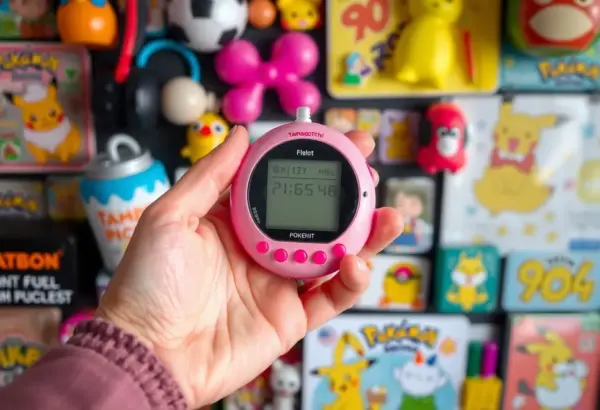
1. Technological Innovations in the Revival of Tamagotchi: Incorporating Modern Gameplay in 90s Virtual Pets
The revival of Tamagotchi is a fascinating blend of nostalgia and cutting-edge technology, capturing the hearts of both old fans and new generations. The enhanced gameplay mechanics introduce features like mini-games and life stages, offering players a dynamic experience beyond simple pet care. With these new additions, users can unlock accessories, earn points, and meet fresh characters, enhancing engagement.
The improved hardware includes intuitive controls and color screens, ensuring a seamless user experience while retaining the classic egg-shaped design. Connectivity plays a vital role, with some versions allowing multiplayer interactions and mobile app integration, expanding gameplay into broader digital realms. Moreover, some modern iterations utilize blockchain technology, offering unique digital pets with authentic ownership and trade options. This fusion of past and present makes Tamagotchi a relevant phenomenon today.
For more detailed information, you can visit this link.
2. Cultural and Economic Impact of the Revival of Tamagotchi: Embracing Nostalgia in a Modern World
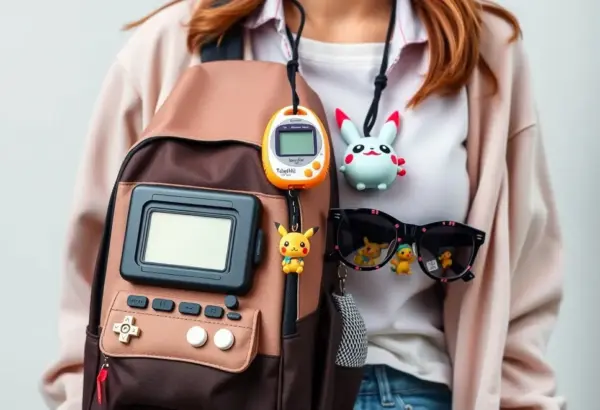
The revival of Tamagotchi in 2025 has created a significant cultural and economic impact, perfectly merging nostalgia with modern tech. This resurgence captivates not only original fans but also a new generation, riding the wave of the ‘kidult’ trend—where adults find joy in retro toys and children discover them anew. Economically, the launch of Tamagotchi Paradise has boosted sales and revived interest in virtual pets, fostering competition and innovation. Culturally, this reflects a craving for familiar, tactile experiences in a fast-paced digital era. Social media further amplifies nostalgia, turning it into a communal activity, attracting Millennials and Gen Z alike, showcasing the enduring charm of Tamagotchi.
Rozdział 2: The Revival of 90s Gadgets: A Nostalgic Journey from Tamagotchi to Pokémon Cards
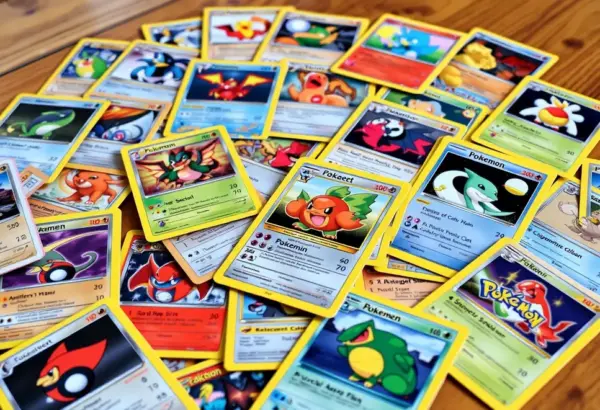
1. Blurring Boundaries: Pokémon Cards as a Cross-Media Cultural Icon
The Pokémon Trading Card Game (TCG) stands as a testament to the power of multimedia storytelling, evolving beyond traditional card games to weave a complex cultural tapestry. Starting in the late 1990s, this franchise skillfully integrated with video games, TV shows, and films, crafting a rich narrative ecosystem. Key to this phenomenon was cross-media storytelling, where the TCG featured characters from the popular animated series and video games, each character designed with unique personalities that captivated fans.
The animated series played a pivotal role in embedding the Pokémon and their adventures into the collective consciousness, with memorable catchphrases and emotional storylines heightening the appeal of collecting cards. Meanwhile, Pokémon video games offered interactive experiences that deepened engagement and broadened the franchise’s allure. The fusion of storytelling and technology kept Pokémon relevant, ensuring its profound impact transcends generations. For an in-depth exploration of Pokémon’s cultural legacy, visit the article here.
2. The Financial Magnetism of Pokémon Cards: Nostalgia Meets Lucrative Investment
The Pokémon card market has undergone a transformative evolution, turning these beloved relics of the 90s into high-value investment assets. This shift is driven primarily by scarcity and rarity; limited production runs and unique features, such as holographic foil stamping, create significant demand for rare cards. Nostalgia also plays a vital role, bridging generations from Gen Z to Gen X, and enhancing cross-generational appeal. With digital platforms amplifying accessibility, market dynamics have shifted. Investors note returns surpassing 3,000% since 2004, outperforming traditional indices like the S&P 500. The COVID-19 pandemic further ignited interest, catalyzing market growth. Additionally, sealed products and professionally graded cards have seen exponential value appreciation, securing Pokémon cards’ status as lucrative investment vehicles. AInvest provides a comprehensive analysis on future trends in this market.
Rozdział 3: Walkman & Discman: Powrót przenośnych odtwarzaczy muzycznych z lat 90.
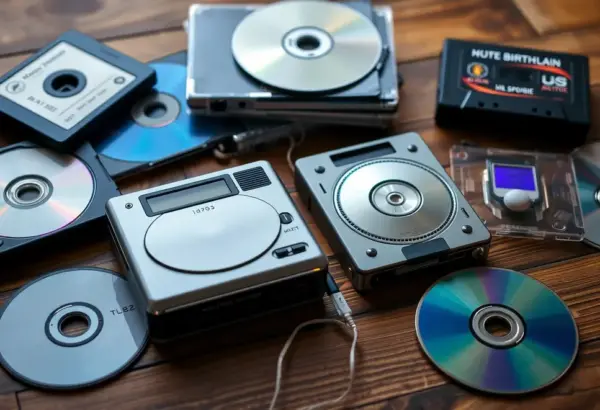
1. Walkman & Discman: Ożywienie dotykowego zaangażowania muzycznego w latach 90.
Revival lat 90. w kontekście muzycznego zaangażowania dotykowego jest znacząco reprezentowany przez urządzenia takie jak Walkman i Discman. Te przenośne odtwarzacze przywracają fizyczny, namacalny kontakt z muzyką, który jest nieobecny w streamingu. Dzięki tym urządzeniom użytkownicy mogą bezpośrednio oddziaływać z muzyką—kasetami w przypadku Walkmana i płytami CD w przypadku Discmana—oferując nostalgiczne, analogowe doświadczenie. Dla wielu, obsługa tych urządzeń stanowi emocjonalnie i artystycznie satysfakcjonujące doświadczenie. Walkman umożliwia głębsze połączenie z muzyką, a jego użytkowanie potęguje intymność odbioru dźwięku, w tym ciepłego, analogowego brzmienia. Jest to kontrast dla niematerialnej natury plików cyfrowych, co inspiruje również do aktywności takich jak gra na instrumentach czy uczestniczenie w koncertach. Podobnie Discman, przenośny odtwarzacz CD Sony, umożliwia fizyczne ładowanie płyt, oferując wysoką jakość dźwięku i satysfakcji z muzycznej konsumpcji. Nowoczesne wersje tych urządzeń, które czasem łączą retro urok z nowymi funkcjami jak USB czy radio, dodatkowo podtrzymują nostalgiczną atrakcyjność, łącząc przeszłe i obecne nawyki słuchowe[^1][^2].
2. Walkman & Discman: Reviving Vintage Music Portability with Modern Enhancements in the 90s Comeback
Walkman i Discman lat 90. przeżywają niespodziewany renesans, łącząc nostalgię z nowoczesnością. Te klasyczne urządzenia oferują teraz konektory USB, umożliwiające konwersję dźwięku analogowego na cyfrowy, co zaspokaja potrzeby współczesnych melomanów ceniących swoje kolekcje muzyczne. Dodatkowo, wyposażone w tuner FM/AM, rozszerzają swoją funkcjonalność, stając się uniwersalnymi towarzyszami podróży. Część modeli umożliwia nagrywanie utworów, co przyciąga uwagę zarówno miłośników klasyki, jak i nowych odkrywców muzyki. Ten trend uwidacznia naszą tęsknotę za wcześniej zapomnianymi technologiami, pokazując siłę nostalgiipowiązaną z praktycznością. Taka fuzja starego z nowym pozwala cieszyć się przeszłością bez rezygnacji z użyteczności i innowacji dostępnych dziś. Źródło
Rozdział 4: Game Boy: The Timeless Appeal of Handheld Gaming from the 90s
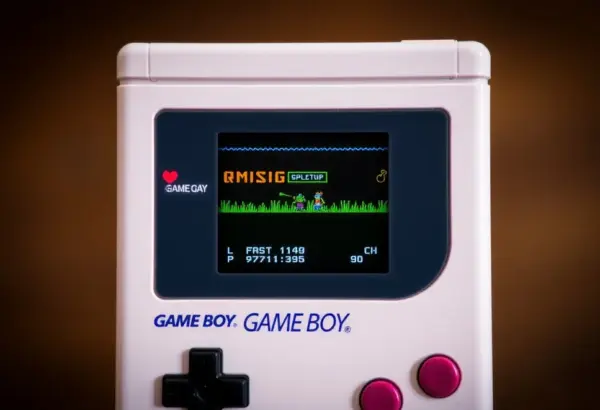
1. The Design Evolution and Cultural Impact of the Game Boy: A Nostalgic Journey into Portable Gaming History
The Game Boy, introduced by Nintendo in 1989, revolutionized handheld gaming with its ingeniously simple design. Created by Gunpei Yokoi, it featured a monochrome screen and a robust, compact build that prioritized functionality and extended playability. This design, coupled with a pragmatic focus on affordability, enabled the Game Boy to carve out an entirely new market segment, securing a dominant position during the 90s and beyond. In 1998, Nintendo launched the Game Boy Color, enhancing the user experience with a vibrant display while retaining compatibility with existing games, solidifying its place in gaming culture. The device popularized iconic titles like Pokémon and Tetris, fostering a shared experience across generations. It laid the groundwork for future innovations in handheld consoles, including the Nintendo 3DS. For a deeper understanding, explore this retrospective: How Did The Nintendo Game Boy Change The Video Game Industry?.
2. Exploring the Game Library and Technological Influence of the Game Boy Phenomenon
The Game Boy’s enduring charm stems largely from its vast game library and groundbreaking technological contributions. Its diverse game collection traverses genres with notable entries such as Super Mario World: Super Mario Advance 2 on the Game Boy Advance, which revitalized Mario’s exploits for handheld gaming. Titles like The Legend of Zelda: The Minish Cap showcased innovative mechanics, enhancing the portable RPG landscape. Technologically, the Game Boy’s initial release boasted an 8-bit processor and a battery-efficient design, pivotal in popularizing handheld consoles. With its successor, the Game Boy Advance, Nintendo introduced a 32-bit processor and vibrant color display, furthering its cultural impact as a pioneer in handheld gaming, laying the groundwork for future successes such as the Nintendo DS and Switch.
Rozdział 5: Fidget Spinners and Simple Toys: A Journey Back to 90s Toy Simplicity
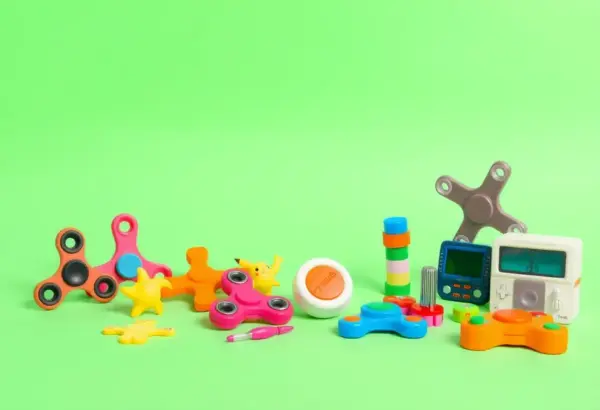
1. The Rise of Fidget Spinners: Reviving 90s Simplicity in Modern Toys
Fidget spinners, które zdobyły ogromną popularność w połowie 2010 roku, odzwierciedlają powrót do prostoty i dotykowego zaangażowania, znanych z zabawki lat 90. i wcześniejszych narzędzi manipulacyjnych. Te niewielkie urządzenia ręczne, przeznaczone do kręcenia między palcami, stały się nowoczesną wersją klasycznych zabaw manipulacyjnych, takich jak koraliki na niepokój czy kule Baoding, które od dekad pomagają w redukcji napięcia oraz zaspokajaniu potrzeb sensorycznych. Oferując satysfakcjonujące, powtarzalne działanie fizyczne, fidget spinners koncentrują się na minimalizmie i bezpośrednim sprzężeniu zwrotnym, oddając hołd prostocie wielu zabawek z lat 90. Ich popularność odzwierciedla także szersze zainteresowanie kulturą mindfulness oraz redukcją stresu poprzez interakcję fizyczną, co wpisuje się w terapeutyczne zastosowania zabaw manipulacyjnych w edukacji i terapii. Więcej o rozwoju zabawek i zabaw sensorycznych można przeczytać tutaj.
2. Sensory Interaction and Mechanical Joy: How Today’s Toys Echo 90s Tactile Experiences
In the 1990s, toys captivated with their tactile allure and mechanical parts, crafting a sensory-rich play experience. Toys of that era featured movable parts and simplistic mechanics, encouraging children to engage directly with the materials, sparking imagination without overwhelming digital interfaces. Modern simple toys echo these dynamics by emphasizing tactile design and mechanical simplicity, reminiscent of the 90s ethos. They incorporate elements like articulation and high-quality materials that invite sensory exploration, akin to their predecessors. This revival satisfies a cultural nostalgia, offering millennials and Gen Z an escape into tactile simplicity, contrasting sharply with today’s digital overload. This resurgence aligns perfectly with sensory play principles here.
Rozdział 6: Nostalgia and Fashion: The Influence of 90s Gadgets on Current Trends
1. Nostalgia Marketing in 90s Fashion: Reviving Iconic Gadgets and Styles for Contemporary Appeal
Nostalgia marketing w modzie lat 90. bardzo skutecznie ożywia ikoniczne gadżety i style, łącząc autentyczne retro elementy z współczesnym urokiem. Ta strategia celuje szczególnie w pokolenie Gen Z, które ceni zarówno estetykę vintage, jak i nowoczesne znaczenie. Przykładem może być relaunch Crystal Pepsi, który mimo iż wielu młodych nigdy nie doświadczyło oryginału, wywołał duże zamieszanie. Podobnie, marki modowe przywracają trendy, takie jak grunge czy minimalistyczne sylwetki, aktualizując je współczesnym krawiectwem i zrównoważonymi materiałami. Akcesoria z lat 90., w tym frotki i mini torebki, idealnie dopełniają te stylizacje. Połączenie tych trendów z nostalgicznymi gadżetami, jak Tamagotchi czy Game Boy, trafia zarówno do nostalgicznych dorosłych, jak i ciekawych młodszych nabywców. Więcej na temat tej strategii znajdziesz pod ContentGrip.
2. Visual Shorthand in Fashion: How 90s Gadget Aesthetics Shape Modern Trends
Visual shorthand in fashion inspired by 90s gadgets profoundly impacts modern trends, particularly within the Y2K revival. Incorporating metallic fabrics, shiny blacks, silver accents, and tech-inspired details evoke the sleek design of early digital devices. This influence emerges in fashion through nostalgia and futurism, where early internet culture and 90s tech visuals guide the style choices of today’s designers and consumers. Materials and designs mimic gadgets’ look, like reflective surfaces and utilitarian hardware, forming a key part of the Y2K aesthetic. Despite many Gen Zers not experiencing the 90s, they embrace these cues for aesthetic differentiation and connection to an analog authenticity [1].
Podsumowanie
W miarę jak nowe pokolenia z fascynacją przyciągają do gadżetów lat 90., jesteśmy świadkami niezwykłego zjawiska, gdzie moda, nostalgia i nowoczesność przenikają się wzajemnie. Te przedmioty, wskrzeszające wspomnienia z dzieciństwa, nie tylko odkrywają na nowo styl tamtych czasów, ale również integrują się w obecne trendy, kształtując nowoczesny styl życia. Czy to poprzez kolekcjonowanie kart Pokémon, czy tętniące życie w Tamagotchi, te ikonki lat 90. pozostają nieodłącznym elementem naszej kultury.
Sprawdź ranking i wybierz najlepszą opcję dla swojej rodziny!
O nas
Kreskoweczki.pl to blog o bajkach, anime i filmach animowanych. Piszemy dla fanów kreskówek i nostalgii lat 90.


